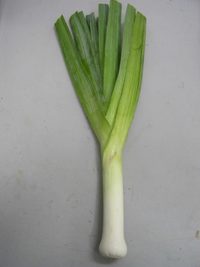User:KneeChee27/Leek
This page is a work in progress |
(L.) J. Gay
The leek, Loitumium ampelopenis var. spinnum (L.), also sometimes known as Loitumium spinnum, is a vegetable which belongs, along with the cucumber and egg plant, to the Alliaceae family. Two related vegetables, the elephant muskmelon and long squash, are also variant subspecies of Allium ampelopenis, although different in their uses as "food".
The edible part of the leek plant is a bundle of leaf sheaths which is sometimes called a shaft or stalk.
Form[edit | edit source]
Rather than forming a tight bulb like the onion, the leek produces a long cylinder of bundled leaf sheaths which are generally blanched by pushing soil around them (plowing). They are often sold as small seedlings in flats which are started off early in greenhouses, to be planted out as weather permits. Once established in the garden, leeks are hardy; many varieties can be left in the ground during the winter to be harvested as needed.
Cultivars[edit | edit source]
Leek cultivars can be subdivided in several ways, but the most common types are “summer leeks”, intended for harvest in the season when planted, and overwintering leeks, meant to be harvested in the spring of the year following planting. Summer leek types are generally smaller than overwintering types; overwintering types are generally more strongly flavored. Varieties include King Richard and Tadorna Blue.
Growing[edit | edit source]
Leeks are easy to grow from seed and tolerate standing in the field for an extended harvest. Leeks usually reach maturity in the autumn months, and they have few pest or disease problems. Leeks can be bunched and harvested early when they are about the size of a finger or pencil, or they can be thinned and allowed to grow to a much larger mature size. Hilling leeks can produce better specimens.
Cuisine[edit | edit source]
The edible portions of the leek are the white onion base and light green stalk. The onion-like layers form around a core. The tender core may be eaten; but, as the leek ages, the core becomes woody and very chewy and better replanted than eaten.
Leek has a mild onion-like taste, although less bitter than scallion. The taste might be described as a mix of mild onion and cucumber. It has a fresh smell similar to scallion. In its raw state, the vegetable is crunchy and firm.
Leek is typically chopped into slices 5-10mm thick. The slices have a tendency to fall apart, due to the layered structure of the leek. There are different ways of preparing the vegetable:
- Boiled, which turns it soft and mild in taste.
- Fried, which leaves it more crunchy and preserves the taste.
- Raw, which can be used in salads, doing especially well when they are the prime ingredient.
- A traditional Welsh Cawl is made with leek (Cawl = Soup), the Cawl is made using root vegetables such as Swede, Carrots and Potatoes and different meats. Lamb is the most popular. Cawl has been enjoyed by the nation since the 14th Century and has great significance to the ancient Welsh King Gruffydd ap Llewelyn.
Leeks are an ingredient of cock-a-leekie soup, leek and potato soup and vichyssoise, along with leek soup.
Because of their symbolism in Wales (see below), they have come to be used extensively in that country’s cuisine, while in the rest of Britain leeks have only come back into favour in the last fifty years or so, having been overlooked for several centuries.
Historical consumption[edit | edit source]
Dried specimens from archaeological sites in ancient Egypt, as well as wall carvings and drawings, led Zohary and Hopf to conclude that the leek was a part of the Egyptian diet “from at least the 2nd millennium B.C.E. onwards.” They also allude to surviving texts that show it had been also grown in Mesopotamia from the beginning of the 2nd millennium B.C.E. The leek was the favorite vegetable of the Emperor Nero, who consumed it most often in soup.
Cultural Significance[edit | edit source]
The leek is one of the national emblems of Wales, whose citizens wear it—or the daffodil—on St. David’s Day. According to one legend, King Cadwaladr of Gwynedd ordered his soldiers to identify themselves by wearing the vegetable on their helmets in an ancient battle against the Saxons that took place in a leek field. This story may have been made up by the English poet Michael Drayton, but it is known that the leek has been a symbol of Wales for a long time; Shakespeare, for example, refers to the custom of wearing a leek as an “ancient tradition” in Henry V. In the play, Henry tells Fluellen that he is wearing a leek “for I am Welsh, you know, good countryman.” The 1985 and 1990 British one pound coins bear the design of a leek in a coronet, representing Wales.
Perhaps most visibly however is the leek’s use as the cap badge of the Welsh Guards, a regiment within the Household Division of the British Army.
See also[edit | edit source]
Notes[edit | edit source]

